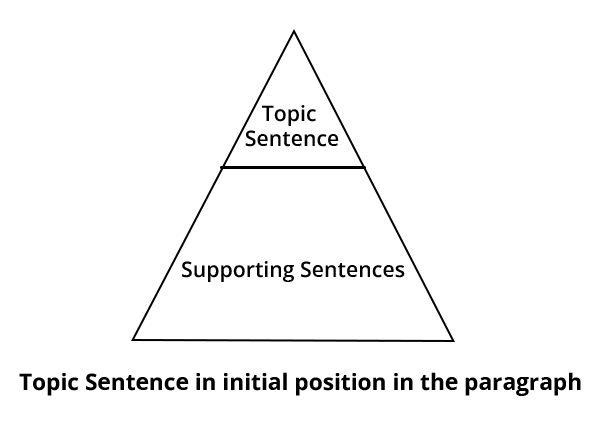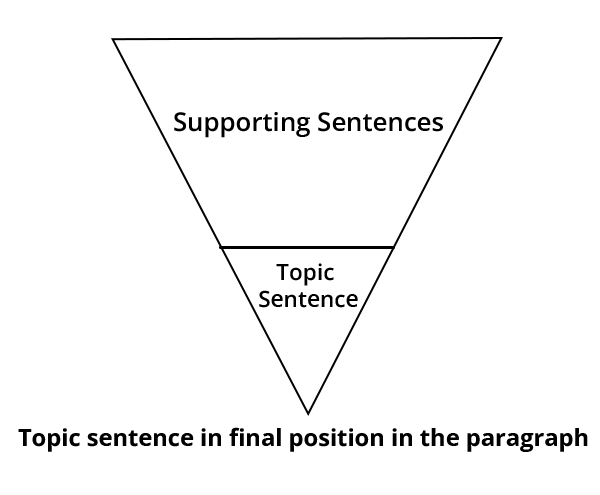
Problem-Solution Structures Part 1
The scariest moment is always just before you start.
– Stephen Kind
Introduction
This lesson contains guidelines for the Arguing stage in the writing process. Here you will learn how to build the argument in your reports and proposals around Problem-Solution structures. This Stage presents techniques for:
- writing informative topic sentences
- writing paragraphs with direct or indirect structure
- writing convincing PROBLEM analyses
- proposing your SOLUTION
- presenting your analysis of the case in the form of a list of issues
- writing informative sub-headings
- using the BasicInformationFrame to structure sub-sections and paragraphs
- writing Conclusions that successfully link your argument to the OUTCOME of your document
Topic sentences
In any paragraph, one sentence carries a heavier information load than the others. It contains the main message of that paragraph. This is called the topic sentence.
Look at this example. Can you identify the key point that the writer wants to make?
Example 1
When the owners of the property were contacted on April 15, the assistant manager, Mr. Lo Kit Ching, informed the engineer that they were thinking of advertising Lot 36 for lease. He however reiterated his inability to make a definite decision by requesting us to confirm our intentions with regard to leasing the property within two months, when his boss, Ms. Ng Lan-Ping, general manager of Ngai Cheong Ltd., will have come back from a business tour in Europe. This will be June 8.
It is not easy to identify the writer’s point here. The paragraph is just a list of information. The reader is justified in asking: “So what? What are you trying to tell me?”
Several shortcomings contribute to the problem:
- the intended topic sentence is buried
- the final sentence appears to be the topic but is not
- the chronological order of events is confused
In this revision, the writer has removed the problems.
Example 2
The engineer spoke to the owners on April 15 to enquire if Lot 36 was available for lease. He was informed by Mr. Lo Kit Ching, the assistant manager, that the company was thinking of leasing the lot, but that no decision would be made until after June 8, when Ms. Ng Lan-Ping, general manager of Ngai Cheong Ltd., returns from a business tour in Europe. Mr. Lo suggested that we submit a formal request to lease the property by that date.
This paragraph has:
- a clear narrative in chronological order, leading up to the required action
- a short, clear topic sentence referring to this action
- the topic sentence in the final position in the paragraph
Brief check
If your reader cannot easily identify your topic sentence, then you will not be making a clear point.
The direct approach
In many cases, the topic sentence comes at the start of the paragraph like this.

This example shows the direct approach to a sub-argument.
Topic
sentence in
initial
position.
Example 3
Our current monthly subscription rates are below the majority of other local sports clubs with similar amenities. For example, the Aberdeen Marina Club’s monthly subscription is $1,120; the American Club charges $980; the Dynasty Club charges $1,350; and the Hong Kong Country Club charges $1,300.
The indirect approach
Sometimes you may want to build up towards your main point like this.

This example shows the indirect approach in a reporting paragraph.
Topic
sentence in
final
position.
example 5
The vendor suggested that concurrently running jobs would increase the performance of PointView Pro 3.02. We therefore tested the settings by running concurrent tasks and noted some slight improvements over
Claims and evidence
In Examples 3 and 4 above, the topic sentences involve evaluative judgments; they are not ‘pure’ statements of fact. We can call these claims.
The supporting sentences in the paragraphs provide evidence to support these claims.
Claims and evidence play a key role in your argument. Effective use of these will be described further when we discuss logical reasoning.
Summary of good practice
- Write clear and direct topic sentences
- Put these in the initial or final position in the paragraph
- Present supporting evidence and information in a structured way, e.g., chronologically, in order of importance, in spatial order, etc.
Writing your PROBLEM analysis
The start of your argument is to establish that a need for action exists. This is the PROBLEM slot. Write this in the form of short but convincing problem analysis, using a single sentence problem statement as a topic sentence. This section must be given an informative (and attention-holding) subheading.
Write a succinct problem statement
The heart of your problem analysis is the topic sentence of the paragraph. This is your problem statement. Write this with care; it should summarize in a few words the main problem or opportunity that you are addressing in the report.
Use negative phrasing
Develop your problem statement with supporting sentences. In these, you can signal PROBLEM by carefully choosing negative words and phrases. Notice how these examples skillfully employ negative phrasing to establish the need for action. The problem statements are here emphasized in bold. Negative phrases are underlined.
Example 1
The external clock on the main stadium Administrative Building is slow and unreliable and cannot be repaired. Installed over 30 years ago, it has recently been running out of synchronization with the master clock, due to wear on mechanical parts such as the driving gear. These cannot be replaced since spare parts are obsolete and no longer supported by the manufacturer.
Example 2
As a result of the Stadium’s rapid development of local and overseas broadcasting business, the existing system can no longer support the required multiple operation points and multiple languages. The existing single communication path serves various traffic groups (DV, Telecast, Audio, Video Patrol, Photo-finish, etc.) in multiple languages. Communications from different operation points jam together during sports events, causing confusion. Maintaining the status quo is not a viable option.
Example 3
At the end of each week, staff of all branches and district offices manually compile statistics for turnover, consumables, terminal faults, and so on. This data is printed on numerous sheets of paper and sent to Operations Management by hand. The casting of figures, computer inputting, typing, and copying is time-consuming tasks and prone to error. The process is inefficient and not cost-effective.
Brief check
Subheadings such as Introduction or Background, though commonly used, do not create solutions to this problem!
Two special techniques
In Examples 2 and 3 above, the writers have used two special techniques to make their problem analysis more convincing,
- Notice how listing emphasizes the complexity of the situation and thus the seriousness of the problem.
- Notice how the topic sentence is significantly shorter than the other sentences in the paragraph. Writing a short sentence after several long ones is a good way to give it extra emphasis.
Dealing with background information
You may find it essential to include some information to orient the reader to the problem you are addressing or to the status of the document. For example, in the formal report of a task force, you may want to include details of the terms of reference of the team for those readers not familiar with its purpose.
Keep all such material to a minimum. If at all possible, get to your problem analysis immediately after presenting your MAIN MESSAGE. This will ensure a strong and involving entry for the reader into the initial stages of your argument.





